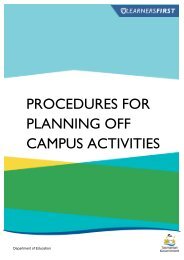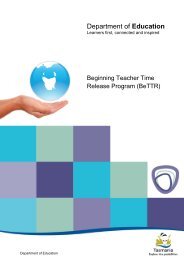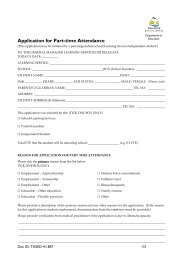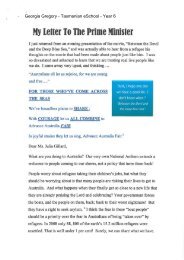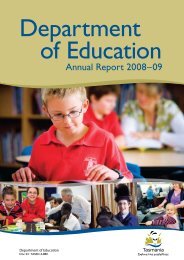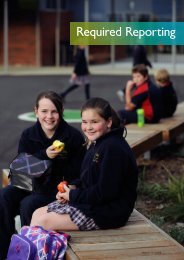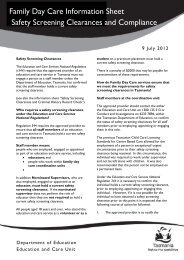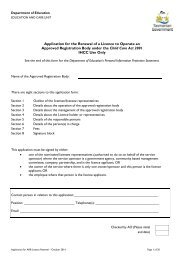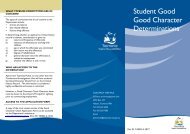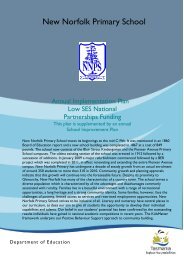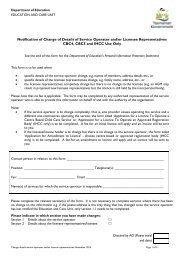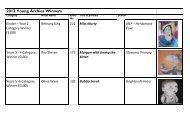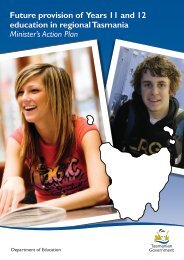Tas Curriculum K-10 - Languages - Italian - Department of Education
Tas Curriculum K-10 - Languages - Italian - Department of Education
Tas Curriculum K-10 - Languages - Italian - Department of Education
Create successful ePaper yourself
Turn your PDF publications into a flip-book with our unique Google optimized e-Paper software.
Assessment indicators – alphabetic languages<br />
Communication<br />
Language as a<br />
system<br />
Language and culture<br />
Listening<br />
Speaking<br />
Reading<br />
Writing<br />
Standard two: Recognises meaning <strong>of</strong> phrases and sentences and responds appropriately in<br />
routine classroom activities and social exchanges<br />
Stage 4 Stage 5 Stage 6<br />
responds non-verbally to familiar classroom instructions e.g. sit, stand<br />
shows understanding <strong>of</strong> routine courtesy exchanges e.g. How are you?<br />
shows understanding <strong>of</strong> familiar questions e.g. What day is it?<br />
Standard two: Takes part in a spoken social routine and responds to familiar questions in everyday<br />
classroom contexts<br />
Stage 4 Stage 5 Stage 6<br />
asks and responds to simple well-rehearsed questions<br />
substitutes new words into well-rehearsed phrases or sentences e.g. in response to flashcards<br />
gives simple instructions e.g. directions such as left, right, straight ahead<br />
Standard two: Reads short repetitive texts containing familiar language and identifies single items<br />
<strong>of</strong> information<br />
Stage 4 Stage 5 Stage 6<br />
finds key words in a text e.g. a shared big book<br />
reads and recognises known words in familiar contexts e.g. classroom vocabulary<br />
uses knowledge <strong>of</strong> letters and sounds to read new words<br />
reads short texts e.g. readers, with familiar repetitive language and support from illustrations<br />
matches familiar words and phrases to illustrations<br />
chooses a few missing words from a short list <strong>of</strong> possible words in simple cloze exercises based<br />
on familiar language<br />
Standard two: Copies and writes phrases or short sentences using well-rehearsed language to<br />
convey simple information<br />
Stage 4 Stage 5 Stage 6<br />
uses models to create their own simple texts e.g. labels, simple captions for pictures and photos,<br />
class big book<br />
spells some common words correctly in own writing<br />
imitates some well-rehearsed language structures, patterns and print conventions when writing<br />
e.g. in speech bubbles<br />
Standard two: Recognises similarities and differences in the patterns <strong>of</strong> oral and written language<br />
arranges words to create simple sentences<br />
notices that sometimes there will be several words or none at all for one word in English<br />
identifies some cognates for familiar words in English<br />
identifies features <strong>of</strong> sentences in both English and the target language e.g. full stops, capital<br />
letters<br />
Standard two: Students understand that people have differences and similarities and make<br />
comparisons between the target language culture and their own. Begins to identify how cultural<br />
values are expressed in language<br />
communicates in the target language using some culturally appropriate gestures and terms <strong>of</strong><br />
address<br />
notices some cultural values and practices within the target language culture and compares with<br />
their own culture e.g. through class discussion <strong>of</strong> realia, folk tales, stories<br />
identifies roles and responsibilities <strong>of</strong> people in the target culture and compares with own<br />
culture e.g. family members, school children<br />
notices that languages have different gender or status forms<br />
notices that different forms <strong>of</strong> language are used to talk to different people e.g. friends, school<br />
contributes positively to discussions about the target culture and language<br />
72




